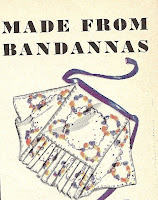
But I didn’t wear aprons at home - they seemed so Donna Reed, so 1950's or 60's – at least not until I got tired of ruined clothes from spattering spaghetti sauce and hot oil, flour and frosting from decorating Christmas cookies, and cherry juice from pitting cherries! Today an apron is one of my kitchen staples.
Aprons have been a part of kitchens and workshops for centuries. People in the past had far fewer clothes than we do today, and protecting their clothes was important. It’s much easier to wash a soiled apron than an entire dress. The blacksmith wore a leather apron to protect against flying sparks from his forge,

and the cooks wore wool aprons over their cotton dresses to guard against sparks from the kitchen fire.

Workmen and shopkeepers wore aprons to protect their clothing from stains. The Workwoman’s Guide, published in 1838, included an illustration and directions for a 'Pantry Apron' (figure 15) for the male servants to wear when trimming lamps, cleaning shoes and knives; and a 'Gentleman’s Workshop Apron' (figure 16) for a carpenter to use when turning wood on a lathe or using tools. Pockets were added for the odd tool or rags.
 Aprons could be attractive as well as serviceable. They weren’t always white (white gets spotted and grimy so quickly). An apron could be made from the skirt of a worn out dress, or a piece of fabric left from a larger project. Half aprons and pinafores were common in every kitchen. There were also specialized aprons for knitting or sewing with special pockets to hold your yarn or sewing tools.
Aprons could be attractive as well as serviceable. They weren’t always white (white gets spotted and grimy so quickly). An apron could be made from the skirt of a worn out dress, or a piece of fabric left from a larger project. Half aprons and pinafores were common in every kitchen. There were also specialized aprons for knitting or sewing with special pockets to hold your yarn or sewing tools.

In the 1970s and more recently, barbecue aprons became a staple of suburban backyard culture – usually something for Dad to wear while turning the steaks.
Today, aprons are retro-chic. According to an article in the September 16, 2009 Sacramento Bee, “Vintage aprons have surged in popularity as the nation becomes more interested in food, cooking and quality time amid an economic downturn.” Maybe. Or maybe people don't like spaghetti sauce on their good jeans.
Today’s aprons fulfill their original purpose – to keep your clothes clean.
[A special thank you to my fellow docents at Sutter's Fort State Historic Park for letting me take their pictures for this blog.]







4 comments:
Interesting apron history. I liked the pictures of old apron patterns.
Annette - Dazzling Dogz
I'm an apron fiend - I have one for each of my messy hobbies (one for ceramics, one for paint, one for woodworking, one for gardening plus extra for friends) and finally got one for cooking so I don't get grease-spots on my favorite tees when I'm making breakfast. I also just sold (in my oddartisttoo shop) a very old apron pattern for $20 - it was so old it didn't have anything printed on the tissue!
Thank you for posting this! Very fascinating read, loved the history, pictures, and current reference! You rock! I've honestly been thinking I need to get around to making one for myself after getting oil on several shirts (and paint on literally everything I own).
Nice post---I had never thought about the fact that aprons were even more important historically because people had fewer clothes! I love aprons---they're so fun. I wish I could find more excuses to wear aprons! Thanks for sharing!
Post a Comment